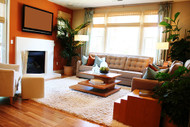Will Area Rugs Help with Noise? Acoustic Insights
Posted by Janice Wells on August 20, 2025
Will Area Rugs Help with Noise? A Practical Acoustic Guide
Walking into a quiet, cozy space feels wonderful, but when a room echoes or bouncing sounds make conversation difficult, it’s anything but. At Rug Goddess, we know that area rugs can play a decisive role in calming acoustics. Let’s explore how and why rugs help with noise, focusing on the key factors: materials, thickness, size/room coverage, and the realities of real-world sound behavior.
Why Rugs Absorb Sound
Unlike hard floors that reflect sound, softer surfaces like area rugs absorb sound waves, reducing echoes and reverberation. Thicker, denser materials such as wool, high-pile fibers, or shag rugs trap sound energy more effectively, dissipating it rather than letting it bounce around the room.
Scientific measurements back this up: carpets over concrete show absorption coefficients that rise with frequency—around 0.08 at 125 Hz, up to 0.72 at 2,000 Hz. Translation? Rugs excel at taming mid-to-high frequencies—helping soften footsteps, chatter, and other sharp sounds. Anyone with children or pets will get this immediately.
Material Matters: What Should You Choose?
- Wool – Natural fibers that excel at sound absorption due to their density and air-trapping structure.
- Shag / High-Pile Rugs – Their longer and plush fibers increase surface area for sound to dissipate.
- Synthetic Blends (e.g., Polyester, Nylon, Polypropylene) – Some high-density options offer reasonable noise dampening, though generally less effective than wool.
The Importance of Thickness and Density
- Thickness matters – Thicker rugs with dense weaves absorb more sound. Beyond aesthetics, it’s a practical tool for noise control.
- Density is key – A tightly woven rug or thick pile traps more acoustic energy, reducing echo and improving clarity in noisy spaces.
Size & Room Coverage—Bigger Is Better
The more floor your rug covers, the more sound it can absorb. Large, well-placed rugs especially help in open-plan areas, bedrooms, or rooms with high ceilings. Placement also matters—put rugs under furniture or seating zones to hit high-traffic sound zones and reduce bounce in critical spots.
What Rugs Can—and Can’t—Do
Yes—Rugs help with:
- Reducing echo, reverberation, and footstep noise inside the room.
- Improving acoustic comfort, particularly in living rooms, bedrooms, or home offices.
- Enhancing speech clarity, softening harsh sounds, and creating a more peaceful ambiance.
But—they’re limited when it comes to:
- Blocking sound through floors or upstairs-to-downstairs transmission. Rugs help only marginally; heavy, multi-layered area rugs or full wall-to-wall carpeting do better at dampening transmission between units.
This particularly insightful comment sums it up:
“A rug will, at best, reduce the noise to some degree. You will still hear downstairs noises, just perhaps a bit less.”
Pro Tips for Maximum Acoustic Impact
- Choose thick, high-pile rugs in dense, fibrous materials.
- Cover as much of the floor as possible, especially in echo-prone spaces.
- Use a good-quality rug pad underneath—more material equals more acoustic benefit.
- Combine rugs with other sound-absorbing elements, like curtains, upholstered furniture, or wall panels, to create a layered sound-dampening effect.
Thoughtful layering makes a noticeable difference.
Final Word—Are Area Rugs a Smart Choice for Noise?
Definitely—for reducing texture noise and echo, improving comfort, and tuning the feel of a room. They won’t eliminate every disturbance, but they surely make your space more serene and acoustically pleasing. Just don't expect an area rug to be a stand-alone solution for loud noises.

